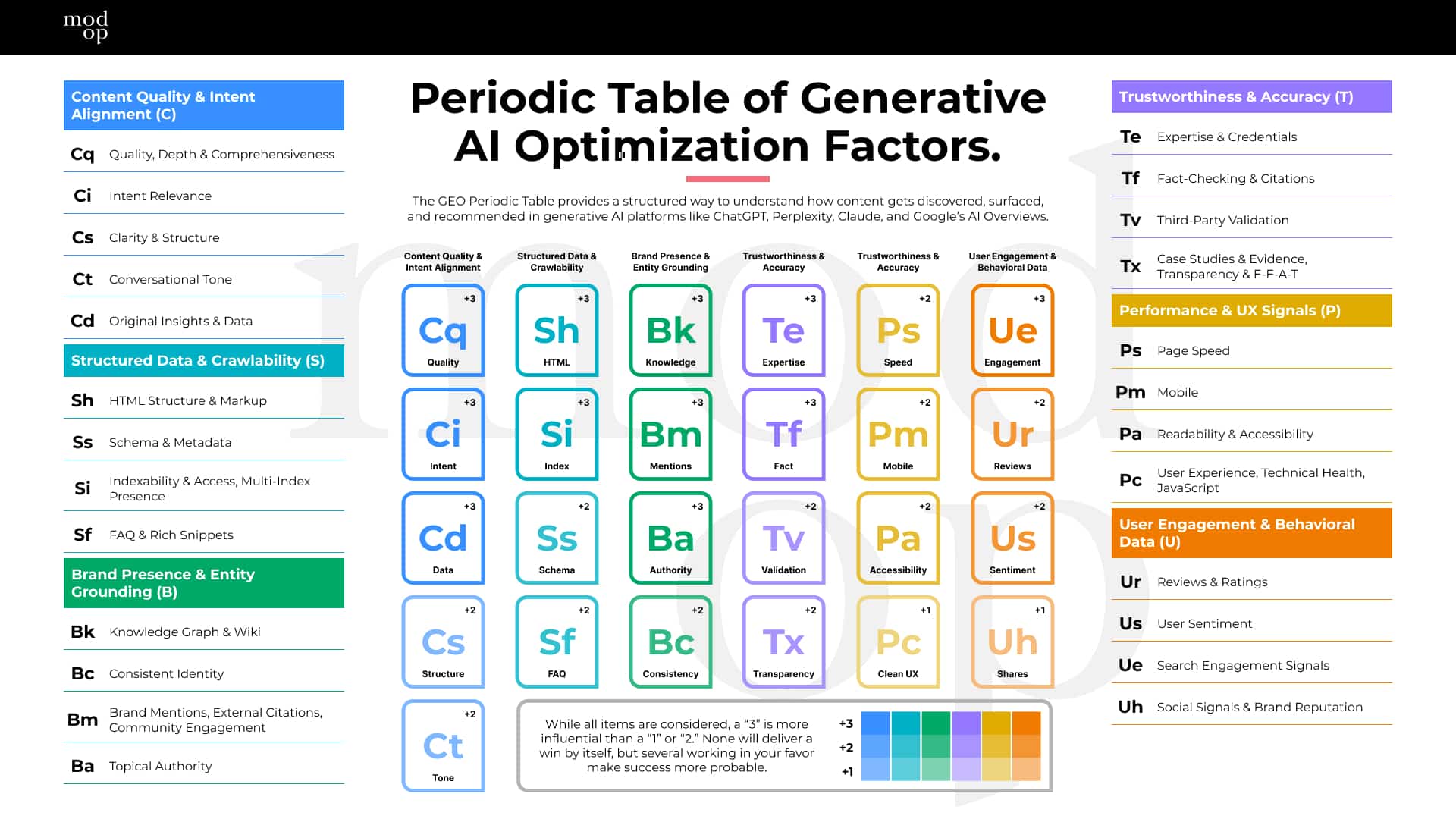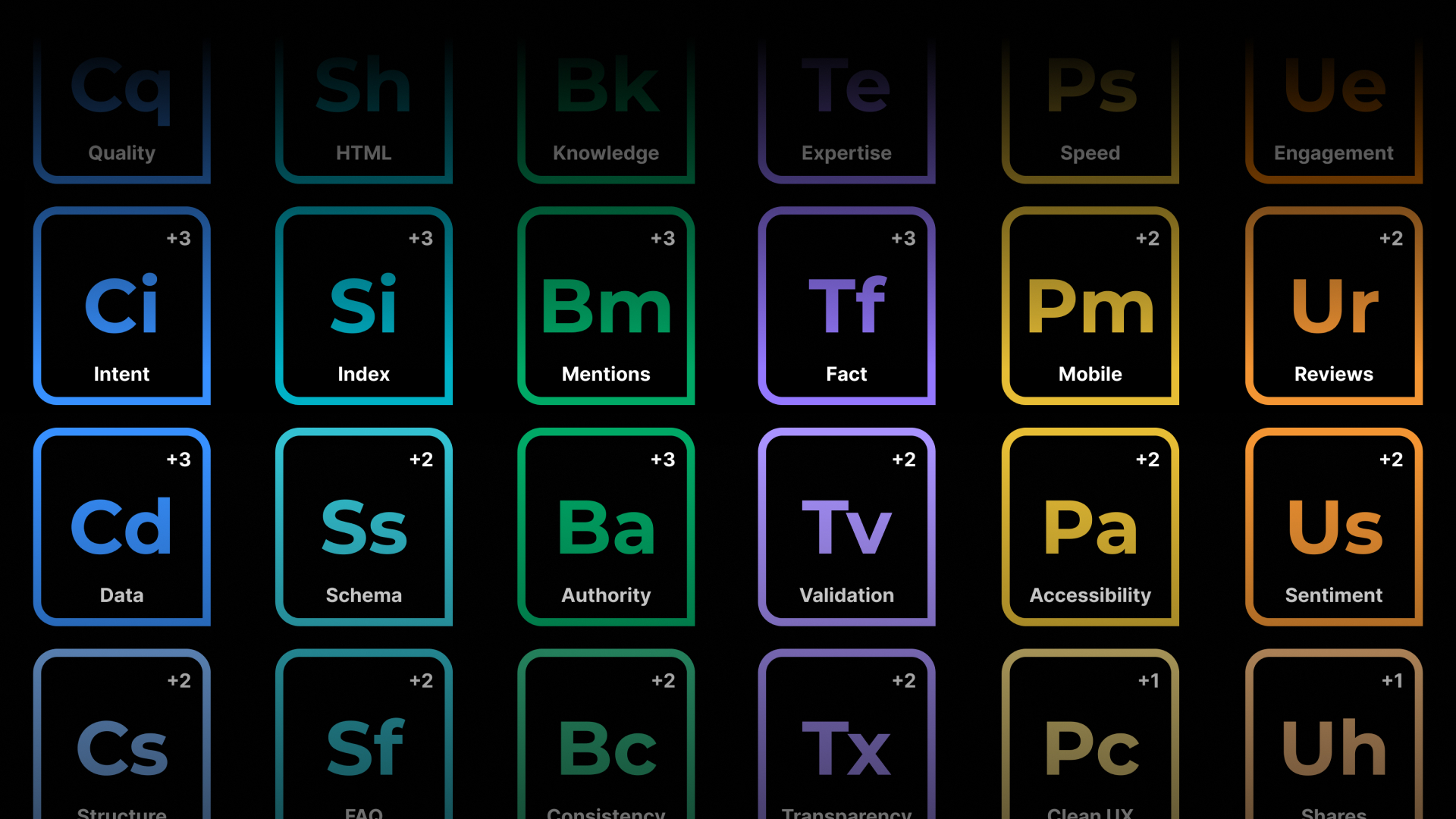Just as the SEO Periodic Table became an essential framework for understanding search engine optimization, our team at Mod Op recognized the need for a similar structure for the age of generative AI. As platforms like ChatGPT, Perplexity, Claude, and Google’s AI Overviews transform how people discover and consume information, we created the GEO Periodic Table to help marketers navigate this emerging landscape. Generative Engine Optimization (GEO) is quickly becoming as critical as SEO once was for traditional search, and much like the SEO Periodic Table helped demystify ranking factors, our framework provides a structured way to understand how content gets discovered, surfaced, and recommended in AI-driven platforms.

Building Visibility in the Age of AI-Powered Search.
I recently joined Mod Op CTO, Tessa Burg on the Leader Generation podcast to discuss how traditional SEO principles translate to Generative Engine Optimization (GEO) and why a “GEO Periodic Table” is key to making sense of this emerging field.
Here are 7 questions asked and answered:
What is the GEO Periodic Table and why do we need it?
The GEO Periodic Table is a conceptual framework inspired by the original SEO Periodic Table. Just like the original table organized ranking factors into categories like content, links, and user experience, the GEO version maps the most important factors that influence visibility in generative AI search engines.
GEO introduces completely new essentials that don’t matter as much in traditional SEO. For example, entity strength, contextual authority, structured knowledge, and cross-channel reinforcement. Without a framework, teams are left guessing—unsure which factors matter most and often missing the essential elements needed to optimize content for generative AI discovery.
How is GEO fundamentally different from traditional SEO?
SEO focuses on ranking factors for traditional search engines where you’re competing for position in a list of blue links. GEO is about discoverability and authority in AI-driven platforms that generate answers instead of listing results. (It’s why GEO is often used in the same conversations as AEO, or answer engine optimization.)
Success now requires answering two questions: “How do I rank #1?” AND “How do I get cited, referenced, and trusted by AI engines when they’re formulating responses?”
What are the most critical factors in the GEO Periodic Table?
Four key elements stand out when considering the most critical factors for GEO:
- Entity strength – This translates to how well-defined your brand, product, or topic is in the knowledge graph. AI engines need to understand what you represent.
- Contextual authority – Are you being cited by trusted third-party sources? It’s not just about having content; it’s about being referenced by others.
- Structured knowledge – This corresponds to content formatted for AI training and retrieval. This means clear, well-organized information that machines can easily parse and understand.
- Cross-channel reinforcement – using PR, paid media, and branding to support your long-term visibility strategy.
What GEO factors should we prioritize for immediate impact?
This is the most critical mindset shift. GEO is long-term infrastructure, not a short-term tactic. With AI engines pulling from multiple sources and constantly learning, you need layered investments.
Think of it in three phases: short-term accelerants like paid campaigns and PR, mid-term reinforcements through structured content libraries and FAQs, and long-term assets like knowledge graphs and authoritative backlinks.
GEO amplifies what was already true about search. It’s always been a marathon, but now the stakes are higher and the timeline is longer.
What does the data tell us about this shift toward AI-powered search?
AI-powered search reduces organic click-through rates by an average of 34.5%. The data shows this shift is accelerating rapidly with 50% of search traffic expected to shift to AI-driven answer engines by 2028.
People are getting answers directly from AI instead of clicking through websites. Google’s AI Overviews confirms this — structured, authoritative content now trumps keyword optimization. This isn’t future speculation, it’s happening now.
How should businesses start preparing for GEO today?
Start with the fundamentals: build structured, authoritative content and optimize for entity recognition. Make sure AI engines can clearly understand what your business does and what expertise you offer. Secure third-party citations through quality PR and relationship building. And, invest in branding and trust signals. In a world where AI engines make decisions about what to surface, trustworthiness is paramount.
But remember, GEO is meant to work alongside SEO rather than replace it. You need SEO for traditional visibility, while GEO handles AI-first discovery.
How do you see the GEO Periodic Table evolving?
Similar to the SEO Periodic Table the GEO framework will evolve over time as AI engines become more sophisticated. We’re already seeing changes in how these platforms handle multi-modal content, real-time information, and personalization.
The framework brings structure to a chaotic landscape, helping teams prioritize, educate stakeholders, and future-proof their strategies for the semantic web.
It’s not about choosing between SEO and GEO—it’s about integrating both into your strategy as we shift toward a world where context, meaning, and trust matter as much as keywords. The businesses that build strong foundations in both SEO and GEO now will be the ones thriving when this transition is complete.
The Latest
We study the game as hard as we play it.
Learn with us what’s now and next.



